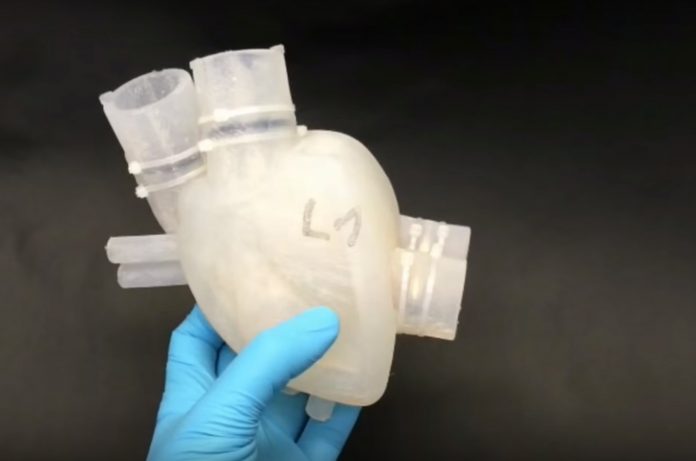This is one artificial heart that actually looks and functions like the real thing. Doctoral students at ETH Zürich just created a completely soft artificial heart using 3D printing technology. Instead of building the organ from separate components, the team molded the squishy silicone material into a single “monoblock” complete with an inner structure that pumps blood with a heartbeat that comes close to the real rhythm.
“Our goal is to develop an artificial heart that is roughly the same size as the patient’s own one and which imitates the human heart as closely as possible in form and function,” said Nicholas Cohrs, the doctoral student at ETH to develop the model, in a press release.
Like a real heart, the artificial heart comes with a right and left ventricle – though they’re separated by an additional chamber that inflates and deflates with pressurized air to pump the fluid from the blood chambers. The motion mimics the muscle contraction performed by a real human heart and creates a heartbeat that’s more like the real thing than any other artificial heart has done before.
Artificial hearts are important because they keep blood pumping temporarily while heart failure patients wait for a donor heart or for their own heart to recover.
But the heart does have a fatal flaw right now. It can only pump out 3,000 heartbeats before the material starts to break down. That means it lives its fleeting life in the span of less than an hour. Researchers will need to find ways to increase the tensile strength of the silicone to make it a viable medical solution. The model right now is just a proof of concept.
About 26 million people currently suffer from heart failure worldwide. And a report released by the American Heart Association says heart failure rates in the U.S. are on the rise. The same report also says heart disease remains the leading cause of death in the U.S., even though the death rate from the disease is dropping.
Artificial hearts are important because they keep blood pumping temporarily while heart failure patients wait for a donor heart or for their own heart to recover. But a lot of artificial hearts today are bulky and are built using metals and plastics that don’t integrate well with the tissue and don’t have as natural a movement. That makes this postgraduate project all the more enticing.
“As a mechanical engineer, I would never have thought that I would ever hold a soft heart in my hands,” said Anastasios Petrou, a fellow doctoral student who led the testing. “I’m now so fascinated by this research that I would very much like to continue working on the development of artificial hearts.”











